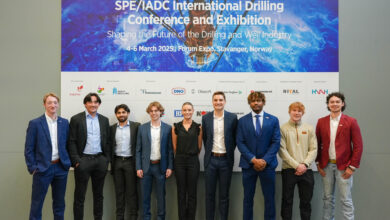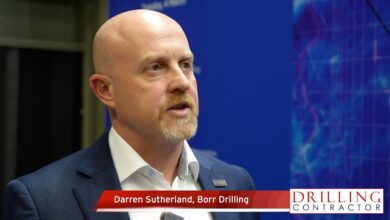Technical Session 17 – Fluids, Cuttings Transport & Cuttings Processing
Editor’s note: These abstracts have been edited for space and clarity. This program is current as of 15 January 2013. Additions, withdrawals and other changes to the conference program after this date may not be reflected. Click here for the most updated program.
TECHNICAL SESSION 17: FLUIDS, CUTTINGS TRANSPORT AND CUTTINGS PROCESSING
SPE/IADC 163567
The Use of IntelliPipe Conveyed Along String Annular Pressure Measurements While Drilling High-Angle Offshore Wells in Trinidad, C.J. Coley, S.T. Edwards, BP
This paper discusses the use of annulus pressure measurements taken at multiple points along the drill string as an enabling technology for monitoring the transport of drilled solids in near real time. Techniques developed internally to convert the significantly increased quantity of data into information (including methods for the processing and analysis of measurements taken during high-density sweeps and ECD fingerprinting) are presented. Other practical concerns, such as sensor placement, sensor accuracy and the importance of a robust IT network to handle the flow of data, are also discussed.
SPE/IADC 163502
High Performance Water-Based Drilling Fluids – An Environmentally Friendly Fluid System Achieving Superior Shale Stabilization While Meeting Discharge Requirement Offshore Cameroon, A. Witthayapanyanon, A. Denax, R.G. Bland, Baker Hughes; J. Leleux, R. Morvan, A. Pomian, J. Segouffin, Perenco
With a regulatory environment moving toward zero discharge, the cost of the waste management with invert emulsion drilling fluids is diminishing their attractiveness. Therefore, when the operator was planning to drill their first well offshore Cameroon in the BAF field, they evaluated high performance water-based mud system (HPWBM) alternatives as these offered the potential advantage of offshore discharge of drilled cuttings and effluents due to absence of oil contamination and lowered waste management costs.
This paper documents the advantages of the HPWBM chosen, its design and performance characteristics in stabilizing reactive clays/shale.
SPE/IADC 163522
A New Fluid Management System and Methods for Improving Filtration and Reducing Waste Volume, Introducing a Step Change in Health and Safety in the Mud Processing Area, A. Kroken, J.K. Vasshus, Cubility AS; T. Omland, B. Aase, Statoil
Effective removal of contaminants from drilling fluids is widely accepted as a key factor in achieving best-in-class drilling performance and reducing fluid cost. Current shaker technology reflects incremental advances in functionality related to size, g-forces and screen technologies. This paper describes the development, qualification and field testing of an alternative solids control solution that provides advances on several aspects that conventional equipment is infested with. The findings presented are based on results obtained both during the qualification process and field testing.
SPE/IADC 163492
Real-Time Evaluation of Hole Cleaning Conditions Using a Transient Cuttings Transport Model, E. Cayeux, Intl Research Inst of Stavanger; T. Mesagan, S. Tanripada, M. Zidan, Statoil; K. Fjelde, University of Stavanger
During a drilling operation, the real-time analysis of surface and downhole measurements can give indications of poor hole cleaning. Nevertheless, it is not always intuitive to understand how and where the cuttings are settling in the borehole, because the transportation of cuttings and the formation of cuttings beds is largely influenced by the consecutive series of actions performed during the operation. Using a transient cuttings transport model, it is possible to get a continuously updated prognosis of the distribution of cuttings in suspension and in beds along the annulus.
This information can be of prime importance for taking decisions to cure and prevent poor hole cleaning conditions. This paper presents how this model has been used to monitor two different drilling operations in the North Sea.
SPE/IADC 163460
Novel Drilling Fluid Design Enables Successful Drilling of Depleted Carbonate Reservoirs Offshore Republic of Congo, A.A. Thomas, M-I SWACO; J. Leleux, Perenco
This paper details case histories from the Emeraude field 13-well drilling program, focusing on the design elements of the novel drilling fluid. An air-energized drilling fluid was developed that enabled all 13 wells in the development program of the Emeraude field, offshore Pointe-Noire, Republic of Congo to be drilled with only 19-bbl downhole losses and zero non-productive time. The energized air-surfactant polymer drilling fluid used on the Emeraude field has potential for drilling similar depleted carbonate reservoirs in West Africa.
Best engineering practices adopted to drill these challenging wells also are described in detail.
SPE/IADC 163519
Evaluated of Filter Cake Mineralogy in Extended Reach and Maximum Reservoir Contact Wells in Sandstone Reservoirs, B.S. Bageri, A. Al-Majed, A. Ul-Hamid, A. Sultan, King Fahd University of Petr and Min; S.H. Al-Mutairi, Saudi Aramco
This study will focus on an aspect which was not fully covered in the literature: the chemical characteristics of filter cake formed in the horizontal section, from its heel to its toe. High pressure fluid loss test were performed using real drilling fluid samples from the field which were collected during drilling horizontal section of sandstone formation. The mineralogy of the external filter cake formed by fluid loss test is described in detail using both scanning electron microscopy and x-ray diffraction.
E-POSTER:
SPE/IADC 163508
Drilling Fluid Selection Methodology For Environmentally Sensitive Areas, K. Dimitriadis, P. Burden, Tullow Oil; S. Thomas, T. Staples, C. Nguyen, K. Clements, M-I Swaco
Tullow operates in areas of Africa which are particularly environmentally sensitive. Selection of drilling fluids in such cases should take into account both technical and environmental criteria in regards to the treatment and disposal of the cuttings and excess fluids.
A thorough study was performed, which comprised shale characterization and inhibition testing on core samples and drill cuttings. Seven drilling fluid compositions were tested, six water based and one synthetic based. A simple rating method was devised for ranking technical and environmental performance or treatment and disposal options for each fluid.
In this particular case, Tullow’s choice of drilling fluid during its exploration and appraisal campaign was driven primarily by the need to use fluids with green credentials and the fact the exploration wells were not particularly demanding from a technical point of view. However, it was recognized the that a system with improved technical performance would be required when drilling the anticipated, more demanding, high angle and extended reach wells during the development drilling.




